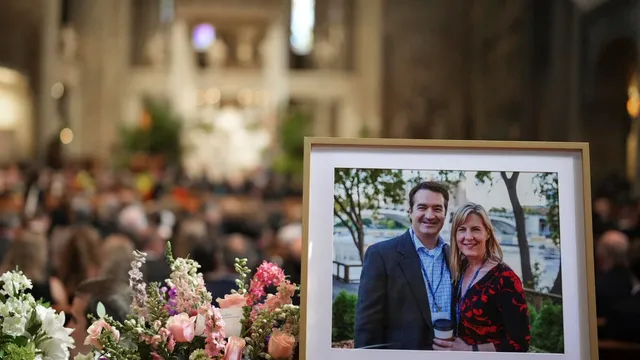
Vance Boelter allegedly murders Minnesota lawmaker Melissa Hortman and her husband Mark
2025-06-28 19:49- Melissa Hortman and Mark were assassinated on June 14, 2025, at their home by Vance Boelter, who was disguised as a police officer.
- Thousands attended the public visitation at the Minnesota State Capitol, where the couple and their dog, Gilbert, were honored.
- Political leaders condemned the violence against public figures, underlining the urgent need for discussions on political safety.
Express your sentiment!
Insights
In the United States, a tragic incident occurred on June 14, 2025, when former Minnesota House Speaker Melissa Hortman and her husband Mark were fatally shot in their home located in Brooklyn Park. The assailant, Vance Boelter, 57, allegedly disguised himself as a police officer to carry out this targeted attack. Alongside the Hortmans, Boelter also shot and severely injured Democratic state Senator John Hoffman and his wife, Yvette, that same night, marking a dark event in Minnesota's political landscape. The motivations for Boelter's actions seem to stem from a politically motivated shooting spree aimed at various Democratic officials in the state. Following the attack, Gilbert, the Hortmans' beloved golden retriever who was with them during the incident, succumbed to his injuries. His ashes were placed beside their coffins during the funeral, which took place after a public visitation at the Minnesota State Capitol was attended by thousands. A powerful public and political outcry has emerged in response to the shooting, as it underscored the increasing risks faced by public figures in today's climate of political extremism. Numerous mourners, including notable figures like former President Joe Biden, former Vice President Kamala Harris, and Minnesota Governor Tim Walz, gathered to honor the Hortmans, emphasizing their contributions to society. Governor Walz remarked on Hortman’s profound influence, stating she would be remembered as one of the most consequential speakers in Minnesota's history. The funeral served not only as a celebration of their lives but also as a poignant reminder of the violence that can overshadow political discourse. As this situation unfolds, Vance Boelter is facing multiple charges, including murder, with the possibility of a death penalty if convicted. This incident has raised questions regarding the safety of public officials and the trends of political violence in the United States, which many view as increasingly precarious. It highlights an ongoing conversation about the need for protective measures and the societal impact of politically motivated attacks.
Contexts
Political violence in the United States has seen fluctuations in intensity and form over the years, often influenced by periods of social upheaval, political division, and economic turmoil. The term encompasses a range of actions, from protests and riots to targeted attacks and organized extremist violence. Understanding these dynamics is crucial to grasping the modern political landscape. The recent rise in political violence can be linked to increasing polarization among the populace, where ideological divisions often escalate into aggressive confrontations. This can be seen clearly in the events surrounding major elections and pivotal political movements, which have frequently resulted in violent outbursts and confrontations across the country. Several factors contribute to the rise of political violence, including the dissemination of misinformation and the radicalization of various groups. Social media platforms have become a breeding ground for extremist ideologies, allowing individuals to connect and mobilize around shared grievances or beliefs. High-profile incidents such as the January 6th Capitol riot illustrate how crowds can be incited to violence by inflammatory rhetoric and longstanding distrust in political institutions. These events not only reveal the fragility of democratic practices but also highlight the role of narrative and perception in shaping public action. As individuals increasingly believe that their rights and freedoms are under threat, the likelihood of resorting to violence heightens. Additionally, the historical context of political violence in the U.S. cannot be overlooked. The nation has a deep-seated legacy of conflict, stemming from civil rights struggles, anti-war movements, and the response to systemic injustices. Each epoch of turmoil brings with it its own unique manifestations of political violence, often as a reaction against perceived oppression or as an attempt to enact rapid societal change. While significant progress toward equality and justice has been made, backlash movements can result in fervent opposition, illustrating the complex interplay between advocacy for social change and the violent counter-responses it may provoke. Preventing political violence requires a multifaceted approach that addresses root causes, such as socioeconomic disparities and political disenfranchisement, as well as enhancing civic education to foster a culture of understanding and dialogue. Policymakers must navigate these challenges with sensitivity, ensuring that efforts to combat violence do not inadvertently infringe upon civil liberties. Moreover, engaging communities in open discussions about political beliefs and grievances holds potential in diffusing tensions before they escalate. Ultimately, understanding and mitigating political violence necessitates recognizing it as both a symptom and a catalyst of deeper societal issues that must be collectively addressed.